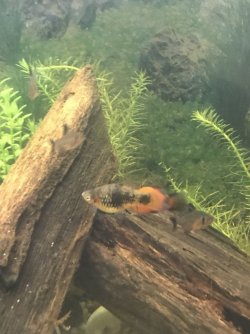No.
In the wild, female livebearers hang out in large groups consisting of between 20 & 50 (but sometimes up to 100 or more) females. These groups have a pecking order with the biggest most dominant female ruling the group and she has a group of girlfriends who back her up. All the other females live in the group but are lower down the pecking order.
The groups of females move around rivers and waterways looking for food and places to hang out. As the groups move around a few males follow the group and try to breed with any females. The groups of males have a pecking order too and the biggest male will bully his smaller mates.
In the confines of an aquarium, the males will constantly harass the females and try to breed with them. This puts undue stress on the females and if there are too many males constantly pestering the females, the females can get sick and die.
It is preferable to keep livebearers in single sex tanks (either male or female but not both sexes together). If you want a group of males and females then have 1 male and at least 6 females (preferably 10 or more females per male).
Female livebearers can carry up to 6 sperm packets from breeding with males and they use 1 sperm packet to fertilise each batch of eggs. The gestation period (from the time she fertilises the eggs to when she gives birth to free swimming babies) is about 1 month. After which she will fertilise another batch of eggs using another sperm packet. This allows female livebearers to produce young about once a month for up to 6 months without any males being present.
If you want to breed livebearers then have a tank with females and let them give birth and use up all the sperm packets they are carrying in their body. Give them a few months without being pregnant and then add a male to the tank for a week before moving him out, or move the female/s into a tank with a male for a week and let them breed. Then move the females back into their own tank.
--------------------------
Livebearers like guppies, mollies, swordtails & platies are regularly infected with gill flukes and intestinal worms. If the females don't give birth within a couple of months, they could have intestinal worms.
You can use Praziquantel to treat tapeworm and gill flukes. And Levamisole to treat thread/ round worms. If you live in the US and can't find these medications, then look for Flubendazole.
Remove carbon from filters before treatment and increase aeration/ surface turbulence to maximise oxygen levels in the water.
You treat the fish once a week for 3-4 weeks. The first treatment will kill any worms in the fish. The second and third treatments kill any baby worms that hatch from eggs inside the fish's digestive tract.
You do a 75% water change and complete gravel clean 24-48 hours after treatment. Clean the filter 24 hours after treatment too.
Treat every fish tank in the house at the same time.
Do not use the 2 medications together. If you want to treat both medications in a short space of time, use Praziquantel on day one. Do a 75% water change and gravel clean the substrate on day 2 & 3. Treat the tank with Levamisole on day 4 and do a 75% water change and gravel clean on day 5, 6 & 7 and then start with Praziquantel again on day 8.
The water changes will remove most of the medication so you don't overdose the fish. The gravel cleaning will suck out any worms and eggs that have been expelled by the fish. Repeating the treatment for 3-4 doses at weekly intervals will kill any worms that hatch from eggs. At the end of the treatment you will have healthier fish.





